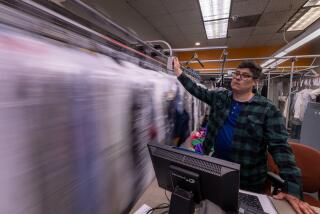Wal-Mart, organized labor’s battle of wills rages on
- Share via
Two dragons danced around a vacant storefront on the edge of Chinatown, stirring up dust.
The centuries-old Chinese ceremony was meant to bring good luck — somethingWal-Mart, which had brought in the performers to celebrate the beginning of construction on a controversial new downtown Los Angeles grocery store — seemed to need.
As a crowd of about two dozen local residents nibbled free cake and Wal-Mart executives exchanged auspicious offerings with local business leaders, several uninvited guests weaved through the crowd. They were activists allied with labor, and the fliers they distributed dismissed Tuesday’s event as a “dog-and-pony show.” Later, they would compete with supporters of the project for face time with journalists covering the affair.
It was another day, another battle in the ongoing war between Wal-Mart and organized labor.
A few weeks ago, an employee at a public relations firm hired by Wal-Mart was caught posing as a reporter at a news conference organized by Warehouse Workers United, a group critical of the retail giant. Wal-Mart quickly dropped the firm, but the incident has helped energize support for a lineup of protests this weekend, including a benefit rock show Friday and a march Saturday that organizers say could draw 10,000 people to the streets.
Labor groups, which take issue with Wal-Mart’s low-end wage scale and non-unionized workforce, have been pressuring elected officials for months to reject contributions from the chain. On Thursday, two top Los Angeles mayoral candidates vying for labor support, City Controller Wendy Greuel and City Councilman Eric Garcetti, pledged not to take money from the company.
In March, Garcetti and his colleagues on the City Council unanimously approved a moratorium on big-box stores in Chinatown. But Wal-Mart had won building permits for the new site the day before. Opponents have filed a complaint that the project should be halted anyway. Whether the complaint will succeed is an open question, but Wal-Mart is going ahead with construction.
The new store, which will occupy 33,000 square feet on the ground floor of an existing apartment building at Cesar Chavez and Grand avenues, is one of more than a dozen “Neighborhood Markets” that Wal-Mart hopes to open in California in the coming years.
At the celebration Tuesday afternoon, a Wal-Mart senior vice president said her company was proud to improve access to fresh and affordable healthy foods.
“Everything we do is connected with our mission of helping people to save money so they can live better,” said Kim Sentovich, who spoke in front of a row of shopping carts filled with produce and construction hats.
She was standing with several local business leaders, including George Yu, president of the Chinatown Business Improvement District. Yu says most people in the neighborhood support the new store. Chinatown has no full-service grocery, he points out, and the storefront where the Wal-Mart is being built has been vacant for years.
He scoffs at suggestions that Wal-Mart will compete with local Chinese grocers, which he says serve a niche market by offering specialty products. “I doubt Wal-Mart will be selling fermented tofu,” he said.
But a vocal group of locals oppose the project, especially the community of artists and gallery owners who have turned the neighborhood into a hub of the Eastside arts scene.
Wendy Yao, who runs a store that sells records, clothing and small-edition artist books near Chinatown’s East Gate, said big chains are a threat to the neighborhood’s distinctive character. “Wal-Mart in general has been in the business of putting independent businesses out of business,” Yao said.
She was one of the organizers of Friday’s benefit concert at Human Resources gallery, where the popular indie-rock band No Age played and labor leaders spoke.
Kathleen Kim, a co-founder of the gallery and a law professor at Loyola Law School, said she thinks resistance to the new store is particularly intense in Chinatown partly because it’s an urban part of the city with a lot of politically conscious young people.
By contrast, another proposed Wal-Mart grocery store, in Panorama City, has generated little opposition. A third proposed grocery, in Altadena, has met with mixed reaction.
Virginia Parks, a professor at the University of Chicago who is writing a book about Wal-Mart’s efforts to expand into Chicago and Los Angeles, says the chain is eyeing new urban markets because its stores already proliferate in rural and suburban areas.
Opening smaller stores in existing retail space is a strategy that allows the chain to avoid the lengthy permitting process required for new buildings, she said. It also allows Wal-Mart to circumvent ordinances like the one passed in Los Angeles in 2006 that triggers a public review when chains want to build superstores.
But Parks said the expansion into urban markets is also generating a new breed of protest, not only among community members but also from labor organizers, who fear the chain’s threat to unionized grocery workers.
Aiha Nguyen, a researcher for the Los Angeles Alliance for a New Economy, a think tank funded partly by labor that has led the fight against the Chinatown store, said Wal-Mart’s labor practices set a bad precedent. “They have been the leaders in reducing wages and making staff part-time,” she said.
Steven Restivo, Wal-Mart’s senior director of community affairs, said Wal-Mart’s wages are above average in some markets and said organized labor’s opposition is nothing new. “They’ve been speaking from the same playbook for more than a decade,” he said.
More to Read
Sign up for Essential California
The most important California stories and recommendations in your inbox every morning.
You may occasionally receive promotional content from the Los Angeles Times.











